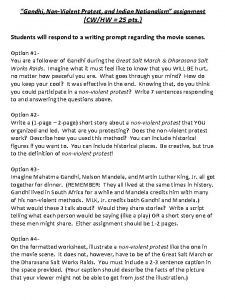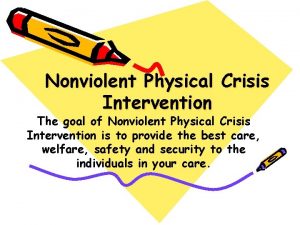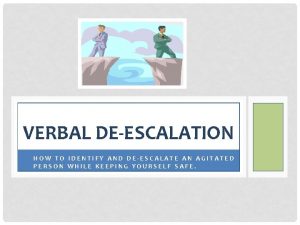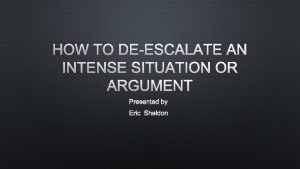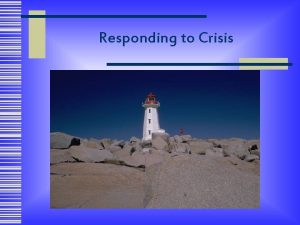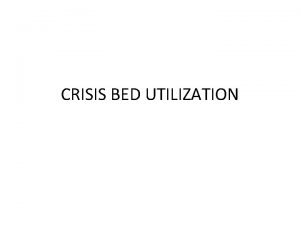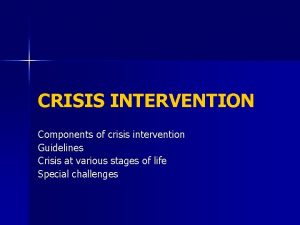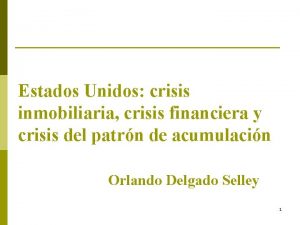Why we Deescalate AN INTRODUCTION TO NONVIOLENT CRISIS



















- Slides: 19

Why we De-escalate AN INTRODUCTION TO NONVIOLENT CRISIS INTERVENTION FOR ANY STUDENT

Behavior de-escalation techniques help teachers: Intervene early and appropriately Avoid over reacting or under reacting Avoid Crisis

The Crisis Development Model Crisis Development/Behavioral Levels Staff Attitudes/Approaches Anxiety Supportive Defensive Directive Risk Behavior Physical Intervention (CPI trained only) Tension Reduction Therapeutic Rapport

Anxiety Think Pair Share: What does it look like? What does it sound like? What is an example?

Anxiety: Definition: A change in behavior We need to know the child’s “normal” behavioral patterns first Examples: Lack of eye contact Hyper Loss movement of verbal skill Nervous ticks Destroying Hoodies things go up

Staff Attitude/Approach to Anxiety: Support! An empathic, nonjudgmental approach Touch the shoulder (depending on student) Show empathy: I hear you, repeat their words to show you understand Have them take a break Have them switch activities

Defensive Think Pair Share: What does it look like? What does it sound like? What is an example?

Defensive Behavior: Definition: Beginning to lose Rationality Examples: False Statements Unresponsive Blame “Why” Language Center Shut Down Watch This!

Staff Attitude/Approach to Defensive Behavior: Directive! Decelerate and escalating behavior They can’t hear or think normally Examples: Short commands- Go sit down, First…Then… This choice or that, take a break Reduce energy- Turn away, planned ignoring

Risk Behavior Definition: Behaviors that may present a risk to self or others Examples: Throwing Yelling at someone Running Hitting Things Away Self or Others

Staff Approach to Risk Behavior: Stay Try Calm to Keep All Kids Safe! Call in your Admin Team!

Quiz Time! I think I’m the link Form Grade Level Teams! Search Kahoot! on Google Chrome Make your team name Enter the pin Try to win some bragging rights!

Role Play Scenarios! A student comes into your class in the morning. He has his hoodie up, he is dragging his feet, he lacks eye contact, and does not say anything after you say, “Good Morning!”

This student is showing anxious behavior Staff Attitudes/Approaches Share Support, Touch empathy, non-judgemental. the shoulder Smile Ask if everything is okay Repeat Find their words to show that you hear them out why they are anxious and if you can help

Role Play Scenario! Students Other are pushing each other to start a fight! students are beginning to crowd around the students who are pushing

These students are showing Risk Behavior They have become a danger to themselves and to others Your job is to attempt to stop the behavior verbally (with authority), to keep all students safe, and to call your admin team.

Last Role Play Scenario Today! A student is repeatedly and challenging your authority by asking why. This student is not curious about material, she is trying to avoid work by annoying and energizing you.

This Student is Showing Defensive Behavior Our job as staff is to be directive Decelerate an escalating behavior They are not going to listen to logic right now DO NOT ENERGIZE! Turn to the side, planned ignoring, continue to teach the other students If you need to engage: 1. Make your voice low and slow 2. Give short commands and or 3. Give short choices (be careful, both choices must be good for you)

Homework! Try it before next Wednesday Plan on sharing the behavior, your actions, and how successful you were.
 Hybrid model of crisis intervention
Hybrid model of crisis intervention Violent vs nonviolent restraints
Violent vs nonviolent restraints Nonviolent comunication
Nonviolent comunication Nonviolent communication chapters
Nonviolent communication chapters Cwhw
Cwhw Why why why why
Why why why why Myasthenic crisis vs cholinergic crisis
Myasthenic crisis vs cholinergic crisis Dont ask why why why
Dont ask why why why Rip van winkle allegory
Rip van winkle allegory Why-why analysis
Why-why analysis Why willy why do you cry
Why willy why do you cry Does the table represent a function why or why not
Does the table represent a function why or why not Does the table represent a function why or why not
Does the table represent a function why or why not Why or why not
Why or why not Analisa akar masalah
Analisa akar masalah Introduction paragraph format
Introduction paragraph format Wrap crisis plan examples
Wrap crisis plan examples Integrated crisis early warning system
Integrated crisis early warning system Crisis communication working group
Crisis communication working group Urgencia hta
Urgencia hta




